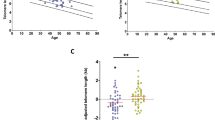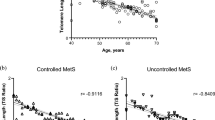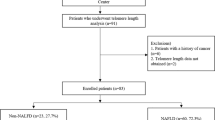Abstract
Increased inflammation and oxidative stress associated with obesity can accelerate aging. Telomere length (TL) has the capacity to serve as an aging indicator at the cellular level. Obesity has a known association with shorter TL. This study evaluated TL of immune cells in a population of obese individuals who underwent gastric bypass surgery. Pre- and post-operative DNA samples were available for 50 subjects who had gastric bypass surgery. DNA was analyzed via quantitative polymerase chain reaction to determine TL. Changes in TL were evaluated by comparing TL at baseline to TL at 3–5 years post gastric bypass surgery. Sixty percent of the individuals in the study observed an increase in TL. Significant lengthening was observed for those with the shortest baseline TL (P=0.0011), but not for those with intermediate baseline TL (P=0.411) or longest baseline TL (P=0.207). Change in TL was negatively correlated with age and triglycerides but not correlated with weight loss induced by bariatric surgery. This study confirms that TL lengthening is observed post bariatric surgery and is the first to detect TL lengthening 3–5 years after surgery.
This is a preview of subscription content, access via your institution
Access options
Subscribe to this journal
Receive 12 print issues and online access
$259.00 per year
only $21.58 per issue
Buy this article
- Purchase on Springer Link
- Instant access to full article PDF
Prices may be subject to local taxes which are calculated during checkout

Similar content being viewed by others

References
Blackburn EH . Structure and function of telomeres. Nature 1991; 350: 569–573.
Wong JM, Collins K . Telomere maintenance and disease. Lancet 2003; 362: 983–988.
Allsopp RC, Vaziri H, Patterson C, Goldstein S, Younglai EV, Futcher AB et al. Telomere length predicts replicative capacity of human fibroblasts. Proc Natl Acad Sci 1992; 89: 10114–10118.
Blackburn EH . Telomeres and telomerase: their mechanisms of action and the effects of altering their functions. FEBS Lett 2005; 579: 859–862.
Njajou OT, Hsueh WC, Blackburn EH, Newman AB, Wu SH, Li R et al. Association between telomere length, specific causes of death, and years of healthy life in health, aging, and body composition, a population-based cohort study. J Gerontol A Biol Sci Med Sci 2009; 64: 860–864.
Gardner JP, Li S, Srinivasan SR, Chen W, Kimura M, Lu X et al. Rise in insulin resistance is associated with escalated telomere attrition. Circulation 2005; 111: 2171–2177.
Lee M, Martin H, Firpo MA, Demerath EW . Inverse association between adiposity and telomere length: The fels longitudinal study. Am J Hum Biol 2010; 23: 100–106.
Muezzinler A, Zaineddin AK, Brenner H . Body mass index and leukocyte telomere length in adults: a systematic review and meta-analysis. Obes Rev 2014; 15: 192–201.
Zannolli R, Mohn A, Buoni S, Pietrobelli A, Messina M, Chiarelli F et al. Telomere length and obesity. Acta Paediatr 2008; 97: 952–954.
Nordfjall K, Eliasson M, Stegmayr B, Melander O, Nilsson P, Roos G . Telomere length is associated with obesity parameters but with a gender difference. Obesity 2008; 16: 2682–2689.
Laimer M, Melmer A, Lamina C, Raschenberger J, Adamovski P, Engl J et al. Telomere length increase after weight loss induced by bariatric surgery: results from a 10 year prospective study. Int J Obes 2016; 40: 773–778.
Formichi C, Cantara S, Ciuoli C, Neri O, Chiofalo F, Selmi F et al. Weight loss associated with bariatric surgery does not restore short telomere length of severe obese patients after 1 year. Obes Surg 2014; 24: 2089–2093.
Wood GC, Chu X, Manney C, Strodel W, Petrick AT, Gabrielsen J et al. An electronic health record-enabled obesity database. BMC Med Inform Dec Mak 2012; 12: 45.
O’Callaghan NJ, Fenech M . A quantitative PCR method for measuring absolute telomere length. Biol Proced 2011; 13: 3.
O’Callaghan NJ, Clifton PM, Noakes M, Fenech M et al. Weight loss in obese men is associated with increased telomere length and decreased abasic sites in rectal mucoas. Rejuvenation Res 2009; 12: 169–176.
Epel E . How 'reversible' is telomeric aging? Cancer Prev Res 2012; 5: 1163–1168.
Garcia-Calzon S, Moleres A, Marcos A, Campoy C, Moreno LA, Azcona-Sanjulian MC et al. Telomere length as a biomarker for adiposity changes after a multidisciplinary intervention in overweight obese adolescents: The Evasyon Study. PLoS ONE 2014; 9: 1–8.
Werner C, Furster T, Widmann T, Poss J, Roggia C, Hanhoun M et al. Physical exercise prevents cellular senescence in circulating leukocytes and in the vessel wall. Circulation 2009; 120: 2438–2447.
Dhaber FS, McEwen BS . Acute stress enhances while chronic stress suppresses cell-mediated immunity in vivo: a potential role for leukocyte trafficking. Brain Behav Immun 1997; 11: 286–306.
Dilley RL, Verma P, Cho NW, Winters HD, Wondisford AR, Greenberg RA . Break-induced telomere synthesis underlies alternative telomere maintenance. Nature 2016.
Acknowledgements
This research was supported by research funds from the Geisinger Health System and the National Institutes of Health (Grant P30DK072488).
Author information
Authors and Affiliations
Corresponding author
Ethics declarations
Competing interests
The authors declare no conflict of interest.
Rights and permissions
About this article
Cite this article
Dershem, R., Chu, X., Wood, G. et al. Changes in telomere length 3–5 years after gastric bypass surgery. Int J Obes 41, 1718–1720 (2017). https://doi.org/10.1038/ijo.2017.156
Received:
Revised:
Accepted:
Published:
Issue Date:
DOI: https://doi.org/10.1038/ijo.2017.156
This article is cited by
-
Telomere length dynamics measured by flow-FISH in patients with obesity undergoing bariatric surgery
Scientific Reports (2023)
-
Telomere shortening associates with elevated insulin and nuchal fat accumulation
Scientific Reports (2020)
-
Response to ‘Regression to the mean, apparent data errors, and biologically extraordinary results’
International Journal of Obesity (2018)
-
Regression to the mean, apparent data errors and biologically extraordinary results: letter regarding ‘changes in telomere length 3–5 years after gastric bypass surgery’
International Journal of Obesity (2018)


